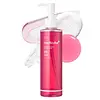What's inside
What's inside
 Key Ingredients
Key Ingredients

No key ingredients
 Benefits
Benefits

 Concerns
Concerns

 Ingredients Side-by-side
Ingredients Side-by-side

Water
Skin ConditioningGlycerin
HumectantAloe Barbadensis Leaf Extract
EmollientCocamidopropyl Betaine
CleansingPanthenol
Skin ConditioningPropylene Glycol
HumectantButylene Glycol
HumectantSodium Chloride
MaskingHydroxyethylcellulose
Emulsion StabilisingPhenoxyethanol
PreservativeSodium Acetate
BufferingChamomilla Recutita Flower Extract
MaskingEthylhexylglycerin
Skin ConditioningDioscorea Villosa Root Extract
Skin ConditioningCellulose
AbsorbentHamamelis Virginiana Extract
AntiseborrhoeicWater, Glycerin, Aloe Barbadensis Leaf Extract, Cocamidopropyl Betaine, Panthenol, Propylene Glycol, Butylene Glycol, Sodium Chloride, Hydroxyethylcellulose, Phenoxyethanol, Sodium Acetate, Chamomilla Recutita Flower Extract, Ethylhexylglycerin, Dioscorea Villosa Root Extract, Cellulose, Hamamelis Virginiana Extract
Water
Skin ConditioningDisodium Cocoamphodiacetate
CleansingGlycerin
HumectantSorbeth-30 Tetraoleate
EmulsifyingCocamidopropyl Betaine
CleansingSodium Chloride
MaskingAcrylates/Beheneth-25 Methacrylate Copolymer
Citric Acid
Buffering1,2-Hexanediol
Skin ConditioningCaprylyl Glycol
EmollientPotassium Cocoyl Glycinate
Hydroxyacetophenone
AntioxidantDipropylene Glycol
HumectantC12-13 Alketh-9
EmulsifyingHydroxyethyl Urea
HumectantDisodium EDTA
Ethylhexylglycerin
Skin ConditioningRosmarinus Officinalis Leaf Oil
MaskingCyanocobalamin
Skin ConditioningHydrolyzed Collagen
EmollientPanthenol
Skin ConditioningSodium Dna
Skin ConditioningNiacinamide
SmoothingCapryloyl Salicylic Acid
ExfoliatingTocopherol
AntioxidantMentha Arvensis Leaf Oil
MaskingHydrolyzed Hyaluronic Acid
HumectantCaprylic/Capric Triglyceride
MaskingCeramide NP
Skin ConditioningAdansonia Digitata Seed Oil
EmollientHydrogenated Lecithin
EmulsifyingCeramide As
Skin ConditioningCeramide Ns
Skin ConditioningCeramide EOP
Skin ConditioningCeramide AP
Skin ConditioningSodium Hyaluronate
HumectantWater, Disodium Cocoamphodiacetate, Glycerin, Sorbeth-30 Tetraoleate, Cocamidopropyl Betaine, Sodium Chloride, Acrylates/Beheneth-25 Methacrylate Copolymer, Citric Acid, 1,2-Hexanediol, Caprylyl Glycol, Potassium Cocoyl Glycinate, Hydroxyacetophenone, Dipropylene Glycol, C12-13 Alketh-9, Hydroxyethyl Urea, Disodium EDTA, Ethylhexylglycerin, Rosmarinus Officinalis Leaf Oil, Cyanocobalamin, Hydrolyzed Collagen, Panthenol, Sodium Dna, Niacinamide, Capryloyl Salicylic Acid, Tocopherol, Mentha Arvensis Leaf Oil, Hydrolyzed Hyaluronic Acid, Caprylic/Capric Triglyceride, Ceramide NP, Adansonia Digitata Seed Oil, Hydrogenated Lecithin, Ceramide As, Ceramide Ns, Ceramide EOP, Ceramide AP, Sodium Hyaluronate
Ingredients Explained
These ingredients are found in both products.
Ingredients higher up in an ingredient list are typically present in a larger amount.
Cocamidopropyl Betaine is a fatty acid created by mixing similar compounds in coconut oil and dimethylaminopropylamine, a compound with two amino groups.
This ingredient is a surfactant and cleanser. It helps gather the dirt, pollutants, and other impurities in your skin to be washed away. It also helps thicken a product and make the texture more creamy.
Being created from coconut oil means Cocamidopropyl Betaine is hydrating for the skin.
While Cocamidopropyl Betaine was believed to be an allergen, a study from 2012 disproved this. It found two compounds in unpure Cocamidopropyl Betaine to be the irritants: aminoamide and 3-dimethylaminopropylamine. High-grade and pure Cocamidopropyl Betaine did not induce allergic reactions during this study.
Learn more about Cocamidopropyl BetaineEthylhexylglycerin (we can't pronounce this either) is commonly used as a preservative and skin softener. It is derived from glyceryl.
You might see Ethylhexylglycerin often paired with other preservatives such as phenoxyethanol. Ethylhexylglycerin has been found to increase the effectiveness of these other preservatives.
Glycerin is already naturally found in your skin. It helps moisturize and protect your skin.
A study from 2016 found glycerin to be more effective as a humectant than AHAs and hyaluronic acid.
As a humectant, it helps the skin stay hydrated by pulling moisture to your skin. The low molecular weight of glycerin allows it to pull moisture into the deeper layers of your skin.
Hydrated skin improves your skin barrier; Your skin barrier helps protect against irritants and bacteria.
Glycerin has also been found to have antimicrobial and antiviral properties. Due to these properties, glycerin is often used in wound and burn treatments.
In cosmetics, glycerin is usually derived from plants such as soybean or palm. However, it can also be sourced from animals, such as tallow or animal fat.
This ingredient is organic, colorless, odorless, and non-toxic.
Glycerin is the name for this ingredient in American English. British English uses Glycerol/Glycerine.
Learn more about GlycerinPanthenol is a common ingredient that helps hydrate and soothe the skin. It is found naturally in our skin and hair.
There are two forms of panthenol: D and L.
D-panthenol is also known as dexpanthenol. Most cosmetics use dexpanthenol or a mixture of D and L-panthenol.
Panthenol is famous due to its ability to go deeper into the skin's layers. Using this ingredient has numerous pros (and no cons):
Like hyaluronic acid, panthenol is a humectant. Humectants are able to bind and hold large amounts of water to keep skin hydrated.
This ingredient works well for wound healing. It works by increasing tissue in the wound and helps close open wounds.
Once oxidized, panthenol converts to pantothenic acid. Panthothenic acid is found in all living cells.
This ingredient is also referred to as pro-vitamin B5.
Learn more about PanthenolChances are, you eat sodium chloride every day. Sodium Chloride is also known as table salt.
This ingredient has many purposes in skincare: thickener, emulsifier, and exfoliator.
You'll most likely find this ingredient in cleansers where it is used to create a gel-like texture. As an emulsifier, it also prevents ingredients from separating.
There is much debate on whether this ingredient is comedogenic. The short answer - comedogenic ratings don't tell the whole story. Learn more about comegodenic ratings here.
The concensus about this ingredient causing acne seems to be divided. Research is needed to understand if this ingredient does cause acne.
Scrubs may use salt as the primary exfoliating ingredient.
Learn more about Sodium ChlorideWater. It's the most common cosmetic ingredient of all. You'll usually see it at the top of ingredient lists, meaning that it makes up the largest part of the product.
So why is it so popular? Water most often acts as a solvent - this means that it helps dissolve other ingredients into the formulation.
You'll also recognize water as that liquid we all need to stay alive. If you see this, drink a glass of water. Stay hydrated!
Learn more about Water